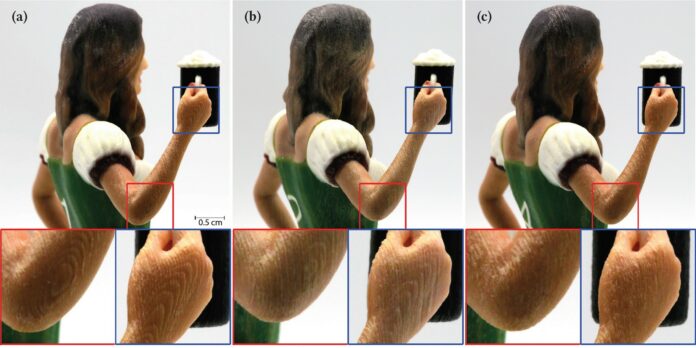
Stair step artifacts appear around the edges of sagittal and coronal reformatted images when wide collimations and non-overlapping reconstruction intervals are used. In conventional 3D printing processes, they are visually disturbing and can even be structurally detrimental to the print.
To generate more accurate surfaces, researchers at the Fraunhofer Institute for Computer Graphics Research IGD have developed a new process for polyjet 3D printers. It minimizes quantization errors so that stair-step artifacts are no longer noticeable in actual printing and are at a level far below the physical effects of the printing process. This results in objects with a smoother and more uniform surface.
Entertainment industry benefits from high-quality print results
To achieve the desired effect, the surface of the object is modulated with a high-frequency signal, such as blue noise. This leads to a distribution of quantization errors to high frequencies, which are then later removed by the function of the human eye and multiple printing processes. Alan Brunton, a member of the three-person author team, explains: “The printing time remains the same, regardless of the process. The dithering process does not require additional computing time either.”
The process is used, for example, in the entertainment industry. Figures and objects are printed for animated movies, video games and board games. In contrast to previous processes, they benefit from the geometric and color precision conferred by the shape dithering approach and thus look especially realistic.
Flexible application
The dithering process can be used as a purely algorithmic method independently of the hardware, i.e. with different polyjet 3D printers. The solution presented in the research paper is used with the Cuttlefish 3D printer driver developed by Fraunhofer IGD. Based on the results now published, in future, the scientists will investigate the further hypothesis of whether the smoother surface of the printed objects also makes them more resilient.
The full research has been described in the paper – Shape Dithering for 3D Printing -.
Remember, you can post free of charge job opportunities in the AM Industry on 3D ADEPT Media or look for a job via our job board. Make sure to follow us on our social networks and subscribe to our weekly newsletter : Facebook, Twitter, LinkedIn & Instagram ! If you want to be featured in the next issue of our digital magazine or if you hear a story that needs to be heard, make sure to send it to contact@3dadept.com





